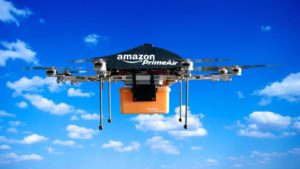04 Mar Flying High: FAA Soars into Expanded Commercial Drone Operations
Your Amazon orders may soon be delivered from above. On January 14, the FAA announced new rules that relax restrictions on the commercial use of small drones. The draft Notice of Proposed Rulemaking (NPRM) would change the Small UAS Rule (14 C.F.R. § 107) by allowing:
- Routine small UAV nighttime operations without waiver; and
- Operations over people.

Amazon’s Prime Air plans for 30-minute deliveries across the world using drones
While the proposed changes ease restrictions on small commercial drones, they do not affect drones weighing more than 55 pounds, recreational drone users, or air carriers. A 60-day open comment period begins when the FAA publishes the proposed rules “at a later date” in the federal register
Night Flight
Under current regulations, drone operators must have a waiver to fly at night. Nighttime waiver applications are the FAA’s most common request, which likely contributed to the streamlined approval process being considered. The changes would allow routine small UAV night operations if the pilot has completed required training and equipped the drone with anti-collision lighting visible for 3 miles. The FAA hasn’t received any reports of accidents or injuries from night flights under the popular waiver program in effect today.
Operations Over People
The proposed changes would also allow overhead drone flights without waiver or exemption, granted certain conditions are met. The requirements vary according to the risk the drone poses to people underneath. The FAA identifies three categories of drones that present different levels of risks and therefore, require different levels of safety compliance by operators.
Category 1 is straightforward – it applies to drones weighing 0.55 pounds or less. Existing requirements of the Small UAS Rule continue to apply as no additional restrictions are required to fly over people. Operators must weigh their aircraft before takeoff to ensure compliance.
Category 2 is more complex. To qualify as Category 2, the drone must first be designed not to cause injury equal to the damage inflicted by a rigid object transferring 11 ft-lbs of kinetic energy. For more about this standard, see Section IV.B.4. The aircraft must not have exposed rotating parts that could lacerate skin nor contain FAA-identified safety defects. Manufacturers must demonstrate to the FAA that their drones meet all of these safety requirements to fly over people without a waiver.
Category 3 builds upon Category 2 with expanded injury thresholds. The drone must not cause injury equal to a rigid object transferring 25 ft-lbs of kinetic energy. It cannot have exposed rotating parts that could lacerate human skin, nor can it have an FAA-identified safety defect. But Category 3 is unique because it incorporates operational limitations. Category 3 drone operations:
- Are prohibited over any open-air assembly of people;
- Must be confined to closed or restricted-access sites with all notified that a drone may fly overhead; and
- May transit but not hover over people (not within closed or restricted-access sites).
The FAA doesn’t describe a specific method to establish compliance but rather leaves it to industry to show evidence that the above requirements are satisfied. Manufacturers submit this evidence using a Means of Compliance.
Drone Traffic Management
The proposed rules also establish the UAS Traffic Management Pilot Project. The pilot project is intended to demonstrate safe integration of drone flight into the nation’s airspace. It is the result of a joint effort between the FAA and NASA. Providers at three locations will manage UAS operations under 400 feet by providing flight planning, communications, aircraft separation, and weather services. Safely integrating drone flight into the nation’s existing air traffic is a crucial step towards the widespread use of commercial drones.
To subscribe to the Journal of Space Law, click here.
—————
Nathaniel Snyder lives in Washington D.C. advising a U.S. congressional office as a space law fellow, as well as being a full-time student within the National Center for Air and Space Law. He’s currently a 2L student editor for the Journal of Space Law.


